
Algae is an informal term for a large and diverse group of photosynthetic eukaryotic organisms. It is a polyphyletic grouping that includes species from multiple distinct clades. Included organisms range from unicellular microalgae, such as Chlorella, Prototheca and the diatoms, to multicellular forms, such as the giant kelp, a large brown alga which may grow up to 50 metres (160 ft) in length. Most are aquatic and autotrophic and lack many of the distinct cell and tissue types, such as stomata, xylem and phloem, which are found in land plants. The largest and most complex marine algae are called seaweeds, while the most complex freshwater forms are the Charophyta, a division of green algae which includes, for example, Spirogyra and stoneworts.

Chlorophyta or Prasinophyta is a taxon of green algae informally called chlorophytes. The name is used in two very different senses, so care is needed to determine the use by a particular author. In older classification systems, it refers to a highly paraphyletic group of all the green algae within the green plants (Viridiplantae) and thus includes about 7,000 species of mostly aquatic photosynthetic eukaryotic organisms. In newer classifications, it refers to the sister of the streptophytes/charophytes. The clade Streptophyta consists of the Charophyta in which the Embryophyta emerged. In this sense the Chlorophyta includes only about 4,300 species. About 90% of all known species live in freshwater. Like the land plants, green algae contain chlorophyll a and chlorophyll b and store food as starch in their plastids.

The glaucophytes, also known as glaucocystophytes or glaucocystids, are a small group of freshwater unicellular algae, less common today than they were during the Proterozoic. Only 15 species have been described, but more species are likely to exist. Together with the red algae (Rhodophyta) and the green algae plus land plants, they form the Archaeplastida. However, the relationships among the red algae, green algae and glaucophytes are unclear, in large part due to limited study of the glaucophytes.
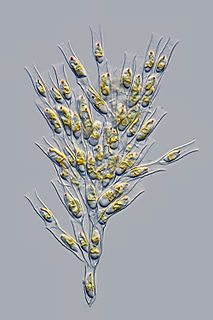
The Chrysophyceae, usually called chrysophytes, chrysomonads, golden-brown algae or golden algae are a large group of algae, found mostly in freshwater. Golden algae is also commonly used to refer to a single species, Prymnesium parvum, which causes fish kills.
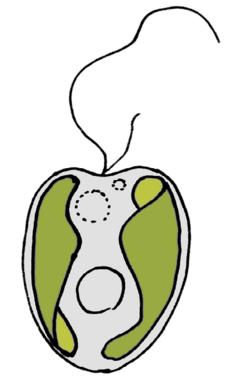
Heterokonts are a group of protists. The group is a major line of eukaryotes. Most are algae, ranging from the giant multicellular kelp to the unicellular diatoms, which are a primary component of plankton. Other notable members of the Stramenopiles include the (generally) parasitic oomycetes, including Phytophthora of Great Famine of Ireland infamy and Pythium which causes seed rot and damping off.

Florideophyceae, is a class of red algaeThey were once thought to be the only algae to bear pit connections, but these have since been found in the filamentous stage of the Bangiaceae.They were also thought only to exhibit apical growth, but there are genera known to grow by intercalary growth.Most, but not all, genera have three phases to the life cycle.

Bangiophyceae is a class of red algae. In some classifications it is merged with the Florideophyceae to form the Rhodophyceae. The Bangiophyceae, as defined traditionally, are paraphyletic. Their taxonomic identification has been difficult because of a lack of distinct morphological features, and the presumed morphological plasticity of the species. Molecular tools are required to elucidate the relationships within this assemblage.
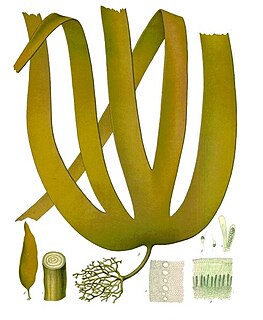
Laminariaceae is a family of brown algal seaweeds, many genera of which are popularly called "kelp". The table indicates the genera within this family. The family includes the largest known seaweeds: Nereocystis and Macrocystis.

The Archaeplastida are a major group of eukaryotes, comprising the red algae (Rhodophyta), the green algae, and the land plants, and some smaller groups such as the glaucophytes. All of the lineages of Archaeplastida have become photoautotrophic, except for the lineage Rhodelphidia, sister to the Rhodophyta, which is still a non-photosynthetic predatorial (eukaryotrophic) flagellate. The Archaeplastida have chloroplasts that are surrounded by two membranes, suggesting that they were acquired directly through a single endosymbiosis event by feeding on a cyanobacterium. All other groups which have chloroplasts, besides the amoeboid Paulinella chromatophora, have chloroplasts surrounded by three or four membranes, suggesting they were acquired secondarily from red or green algae. Unlike red and green algae, glaucophytes have never been involved in secondary endosymbiosis events.

Eustigmatophytes are a small group of eukaryotic algae that includes marine, freshwater and soil-living species.

Ochrophyta is a group of mostly photosynthetic heterokonts. Their plastid is of red algal origin.
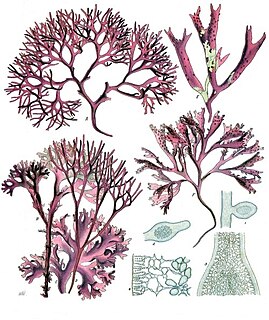
Red algae, or Rhodophyta, are one of the oldest groups of eukaryotic algae. The Rhodophyta also comprises one of the largest phyla of algae, containing over 7,000 currently recognized species with taxonomic revisions ongoing. The majority of species (6,793) are found in the Florideophyceae (class), and mostly consist of multicellular, marine algae, including many notable seaweeds. Red algae are abundant in marine habitats but are relatively rare in freshwaters. Approximately 5% of the red algae occur in freshwater environments with greater concentrations found in warmer areas. Except for two coastal cave dwelling species in the asexual class Cyanidiophyceae, there are no terrestrial species, which may be due to an evolutionary bottleneck where the last common ancestor lost about 25% of its core genes and much of its evolutionary plasticity.
Phaeothamniophyceae is a class of heterokonts. It contains two orders, Phaeothamniales and Aurearenales, and consists of species separated from Chrysophyceae.

Dictyochophyceae sensu lato is a photosynthetic lineage of heterokont algae.

Biliphyta is a subkingdom of algae.
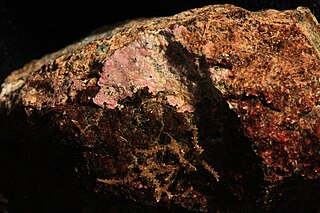
Hildenbrandia is a genus of thalloid red alga comprising 26 species. The slow-growing, non-mineralized thalli take a crustose form. Hildenbrandia reproduces by means of conceptacles and produces tetraspores.

Cyanidiophyceae is a class of unicellular red algae within subdivision Cyanidiophytina, and contain a single plastid, one to three mitochondria, a nucleus, a vacuole and floridean starch. Most are extremophiles inhabiting acid hot springs. The main photosynthetic pigment is C-phycocyanin. Reproduction is asexual by binary fission or formation of endospores.

Batrachospermaceae is a family of fresh water red algae (Rhodophyta). Genera within the Batrachospermaceae generally have a "Lemanea-type" life history with carpospores germinating to produce chantransia. Sporophyte phase with meiosis occurs in an apical cell to produce the gametophyte stage. Pit connections have two pit plug cap layers with the other layer enlarged. This family of freshwater red algae is uniaxial, meaning each filament with a single apical cell. The genera included within Batrachospermaceae are listed in the table below.
Proaulopora is a Cambrian–Ordovician fossil genus of calcareous algae. It has been variously thought to belong to the green algae, red algae or cyanobacteria. It was originally established by the Russian paleontologist Aleksandr Grigoryevich Vologdin in 1937, for species known from the Lower Cambrian of the western Altai Mountains.

Michael Dominic Richard Guiry, is an Irish botanist, who specialises in phycology (algae). See for example the articles. He is the founder and director of the algal database, AlgaeBase.


















